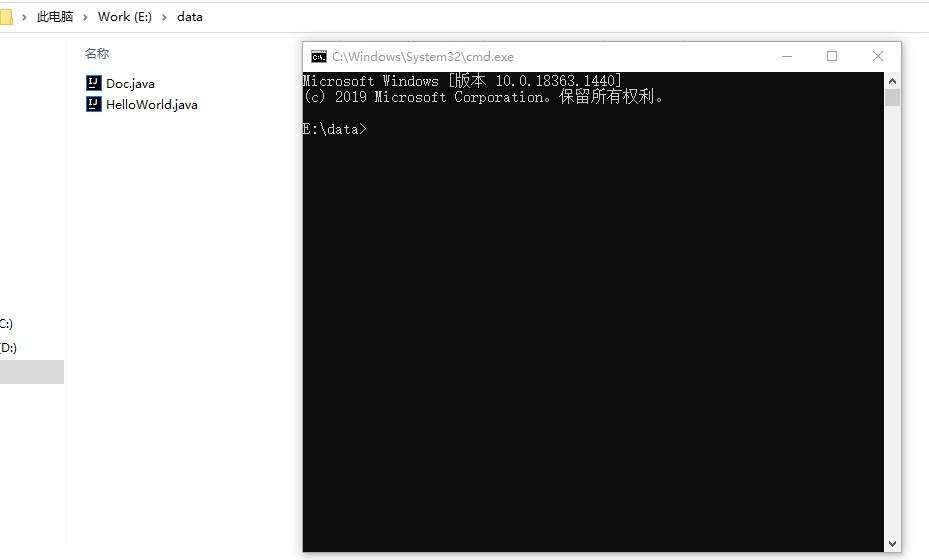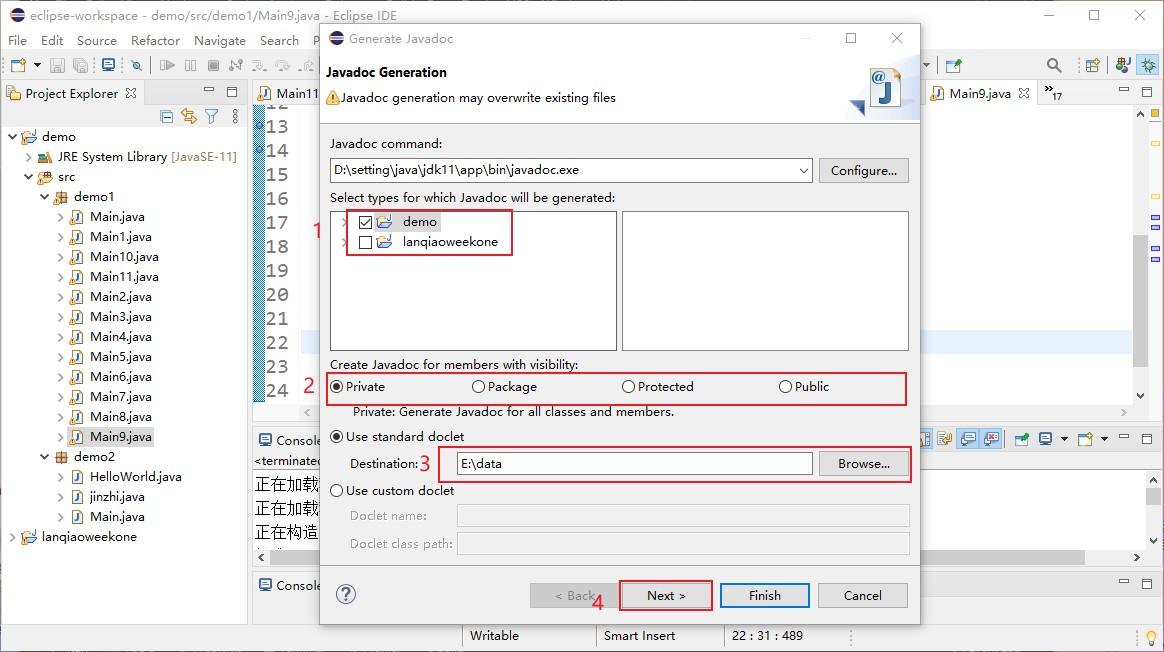Java中怎么实现文档注释,相信很多没有经验的人对此束手无策,为此本文总结了问题出现的原因和解决方法,通过这篇文章希望你能解决这个问题。
使用//进行注释:
//阿平好帅
使用/**/进行注释:
/** 阿平是真的帅/
(三)文档注释
使用/** */进行注释:
/** 阿平也太帅了吧 */
文档注释主要是用来生成java开发文档javadoc的,生成的开发文档和Java本身的API帮助文档是一样的,也就是对你所写的类进行解释说明,所以它还需要搭配一些文档标记,进行解释说明,而且在文档注释中可以使用HTML语言,jdk源码中有大量的文档注释,所以弄懂文档注释可以帮助你更好的看懂源码。
文档注释通常还会配合HTML标签进行使用,比较常用的标签有<p><pre>等标签,p标签用于表示段落,pre标签可用于显示计算机源码。
注意:pre标签中如果有小于号、大于号、例如泛型 在生产javadoc时会报错。
以下文档标记在类、方法、变量和常量上都经常使用。
@link: 用于快速链接到相关代码,使用格式:{@link 包名.类名#方法名(参数类型)}
// 完全限定的类名
{@link java.util.Collections}
// 省略包名,只写类名
{@link String}
// 省略类名,表示指向当前的某一个方法
{@link #toString()}
// 完全限定方法名,包名.类名.方法名(参数类型)
{@link java.lang.String#charAt(int)}@code: 将文本标记为代码样式文本,一般在Javadoc中只要涉及到类名或者方法名,都需要使用@code进行标记,使用格式:{@code text},其会被解析为<code> text </code>
//标记类名
{@code ArrayList}
//标记方法名
{@code isEmpty}
//标记某个代码关键字
{@code null}@param:如果一个类支持泛型时,可以通过@param来解释泛型的类型
/** @param <E> the type of elements in this list */
@author:用来标记作者,如果一段程序是由多个作者来维护,则可以标记多个@author,@author 后面可以跟作者姓名(也可以附带作者邮箱地址)、组织名称(也可以附带组织官网地址)
// 纯文本作者 @author Rod Johnson // 纯文本作者,邮件 @author Igor Hersht, igorh@ca.ibm.com // 超链接邮件 纯文本作者 @author <a href="mailto:ovidiu@cup.hp.com">Ovidiu Predescu</a> // 纯文本邮件 @author shane_curcuru@us.ibm.com // 纯文本 组织 @author Apache Software Foundation // 超链接组织地址 纯文本组织 @author <a href="https://jakarta.apache.org/turbine"> Apache Jakarta Turbine</a>
@see :另请参阅的意思,一般用于标记与本类相关联的类,该标注可以用在类或方法上。
/** * @see IntStream * @see LongStream * @see DoubleStream * @see <a href="package-summary.html">java.util.stream</a> * /
@since:表示从以下版本开始有这个类,标记文件创建时项目当时对应的版本,后面可以跟版本号或是时间。
//跟版本号,以下是ArrayList类里的标记,说明从jdk1.2开始就有该类了 /* * @since 1.2 **/ //跟时间 /** * @since 20 April 2021 */
@version:用于标记当前类版本,默认为1.0
/** * @version 1.0 */
以上是类上常用的文档标注,类上的文档格式如下:
概要描述:通常用一段话简要的描述该类的基本内容。
详细描述:通常用几大段话详细描述该类的功能与相关情况。
文档标注:用于标注该类的作者、时间、版本、参略等信息。
以下是String类的中文档标注的事例:
/**
* The {@code String} class represents character strings. All
* string literals in Java programs, such as {@code "abc"}, are
* implemented as instances of this class.
* <p>
* Strings are constant; their values cannot be changed after they
* are created. String buffers support mutable strings.
* Because String objects are immutable they can be shared. For example:
* <blockquote><pre>
* String str = "abc";
* </pre></blockquote><p>
* is equivalent to:
* <blockquote><pre>
* char data[] = {'a', 'b', 'c'};
* String str = new String(data);
* </pre></blockquote><p>
* Here are some more examples of how strings can be used:
* <blockquote><pre>
* System.out.println("abc");
* String cde = "cde";
* System.out.println("abc" + cde);
* String c = "abc".substring(2,3);
* String d = cde.substring(1, 2);
* </pre></blockquote>
* <p>
* The class {@code String} includes methods for examining
* individual characters of the sequence, for comparing strings, for
* searching strings, for extracting substrings, and for creating a
* copy of a string with all characters translated to uppercase or to
* lowercase. Case mapping is based on the Unicode Standard version
* specified by the {@link java.lang.Character Character} class.
* <p>
* The Java language provides special support for the string
* concatenation operator ( + ), and for conversion of
* other objects to strings. For additional information on string
* concatenation and conversion, see <i>The Java™ Language Specification</i>.
*
* <p> Unless otherwise noted, passing a {@code null} argument to a constructor
* or method in this class will cause a {@link NullPointerException} to be
* thrown.
*
* <p>A {@code String} represents a string in the UTF-16 format
* in which <em>supplementary characters</em> are represented by <em>surrogate
* pairs</em> (see the section <a href="Character.html#unicode">Unicode
* Character Representations</a> in the {@code Character} class for
* more information).
* Index values refer to {@code char} code units, so a supplementary
* character uses two positions in a {@code String}.
* <p>The {@code String} class provides methods for dealing with
* Unicode code points (i.e., characters), in addition to those for
* dealing with Unicode code units (i.e., {@code char} values).
*
* <p>Unless otherwise noted, methods for comparing Strings do not take locale
* into account. The {@link java.text.Collator} class provides methods for
* finer-grain, locale-sensitive String comparison.
*
* @implNote The implementation of the string concatenation operator is left to
* the discretion of a Java compiler, as long as the compiler ultimately conforms
* to <i>The Java™ Language Specification</i>. For example, the {@code javac} compiler
* may implement the operator with {@code StringBuffer}, {@code StringBuilder},
* or {@code java.lang.invoke.StringConcatFactory} depending on the JDK version. The
* implementation of string conversion is typically through the method {@code toString},
* defined by {@code Object} and inherited by all classes in Java.
*
* @author Lee Boynton
* @author Arthur van Hoff
* @author Martin Buchholz
* @author Ulf Zibis
* @see java.lang.Object#toString()
* @see java.lang.StringBuffer
* @see java.lang.StringBuilder
* @see java.nio.charset.Charset
* @since 1.0
* @jls 15.18.1 String Concatenation Operator +
*/
public final class String
implements java.io.Serializable, Comparable<String>, CharSequence {
}@param:该文档标记后面写方法的参数名,再写参数描述。
/**
* @param str
* the {@code CharSequence} to check (may be {@code null})
*/
public static boolean containsWhitespace(@Nullable CharSequence str) {}@return:该文档标记后面写返回值得描述。
/**
* @return {@code true} if the {@code String} is not {@code null}, its
*/
public static boolean hasText(@Nullable String str){}@throws:该文档标记后面写异常的类型和异常的描述,用于描述该方法可能抛出的异常。
/**
* @throws IllegalArgumentException when the given source contains invalid encoded sequences
*/
public static String uriDecode(String source, Charset charset){}@exception:该标注用于描述方法签名throws对应的异常。
/**
* @exception IllegalArgumentException if <code>key</code> is null.
*/
public static Object get(String key) throws IllegalArgumentException {}@see:可用在类与方法上,表示参考的类或方法。
/**
* @see java.net.URLDecoder#decode(String, String)
*/
public static String uriDecode(String source, Charset charset){}以上是方法上常用的文档标注,方法上的文档格式如下:
概要描述:通常用一段话简要的描述该方法的基本内容。
详细描述:通常用几大段话详细描述该方法的功能与相关情况。
文档标注:用于标注该方法的参数、返回值、异常、参略等信息。
以下是String类中charAt方法的示例:
/**
* Returns the {@code char} value at the
* specified index. An index ranges from {@code 0} to
* {@code length() - 1}. The first {@code char} value of the sequence
* is at index {@code 0}, the next at index {@code 1},
* and so on, as for array indexing.
*
* <p>If the {@code char} value specified by the index is a
* <a href="Character.html#unicode">surrogate</a>, the surrogate
* value is returned.
*
* @param index the index of the {@code char} value.
* @return the {@code char} value at the specified index of this string.
* The first {@code char} value is at index {@code 0}.
* @exception IndexOutOfBoundsException if the {@code index}
* argument is negative or not less than the length of this
* string.
*/
public char charAt(int index) {}变量和常量上用的比较多的文档标记是@link和@code,主要注释该常量或变量的基本用法和相关内容。
以下是示例:
/**
* The value is used for character storage.
*
* @implNote This field is trusted by the VM, and is a subject to
* constant folding if String instance is constant. Overwriting this
* field after construction will cause problems.
*
* Additionally, it is marked with {@link Stable} to trust the contents
* of the array. No other facility in JDK provides this functionality (yet).
* {@link Stable} is safe here, because value is never null.
*/
private final byte[] value;
首先先展示下我写的文档注释代码:
HelloWorld.java
package demo2;
/**
* <p>这是一个测试javadoc的类
*
* @author codepeace
* @version 1.0
* @since 1.8
*
*/
public class HelloWorld {
String name;
/**
*
* @param name
* @return name
* @throws Exception
* {@code name}
*/
public String test(String name)throws Exception{
return name;
}
}Doc.java
package demo2;
/**
* <p>这是一个测试javadoc的类
*
* @author codepeace
* @version 1.0
* @since 1.8
*
*/
public class Doc {
String name;
/**
*
* @param name
* @return name
* @throws Exception
* {@code name}
*/
public String test(String name)throws Exception{
return name;
}
}用wiodow打开cmd终端,然后进入要编译的java文件目录的路径中,如下所示:

输入命令:javadoc -encoding UTF-8 -charset UTF-8 *.java,就能将你的java文件编译成帮助文档。
-encoding 是编码格式, -charset是字符集格式,需要查看你文件的编码格式,可以通过打开记事本查看编码格式。


编译成功后你后发现当前路径下会多出很多文件,我们需要的文件是index.html文件。

点开后为如下样式,至此帮助文档生成完毕。

使用idea生成javadoc文档
打开 idea,点击 Tools-> Generate JavaDoc,这样会打开生成 javadoc 文档的配置页面。

配置javadoc文档输出详情:
选择要输出文档的范围,选择是整个项目还是模块还是单个文件。
文档要输出路径。
选择哪些类型的方法或参数可以生成文档。
Locale 选择地区,这个决定了文档的语言,中文就是zh_CN。
传入JavaDoc的参数,一般写 -encoding UTF-8 -charset UTF-8,表示编码格式。

点击确定,运行无误后,打开你所选择的文档输出路径后,选择index.html,就是所输出的javadoc文档。


使用eclipse生成javadoc文档
打开eclipse,点击 Project-> Generate JavaDoc,这样会打开生成 javadoc 文档的配置页面。

配置以下javadoc文档输出详情,后点击next
选择要输出成文档的文件或模块
选择哪些类型的方法或参数可以生成文档
文档要输出路径。

设置文档名后,点击next

设置编码格式 一般写-encoding UTF-8 -charset UTF-8,设置jre版本,然后点击完成,在刚才设置的输出路径中找到index.html即可。

注意点:eclipse的默认编码不是UTF-8,所以要将其修改为UTF-8,修改方法如下:
打开eclipse,点击 Window-> Preferences->Workspace,将默认的GBK编码改为UTF-8即可。


看完上述内容,你们掌握Java中怎么实现文档注释的方法了吗?如果还想学到更多技能或想了解更多相关内容,欢迎关注亿速云行业资讯频道,感谢各位的阅读!
免责声明:本站发布的内容(图片、视频和文字)以原创、转载和分享为主,文章观点不代表本网站立场,如果涉及侵权请联系站长邮箱:is@yisu.com进行举报,并提供相关证据,一经查实,将立刻删除涉嫌侵权内容。